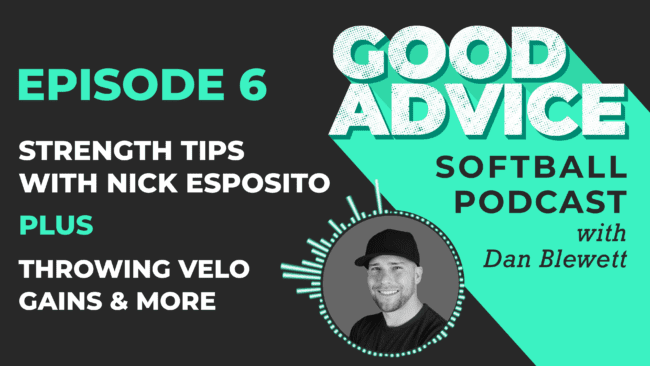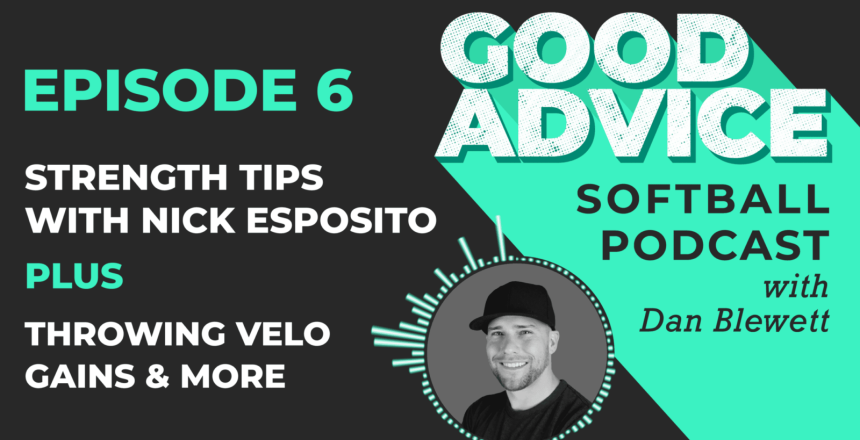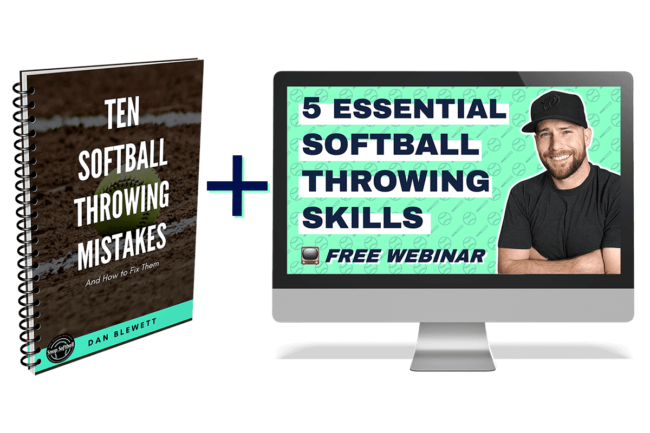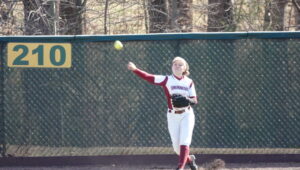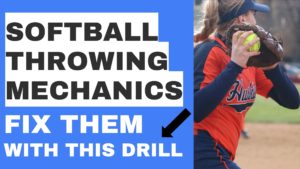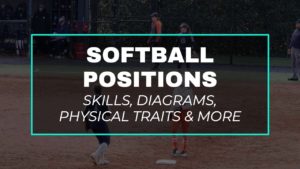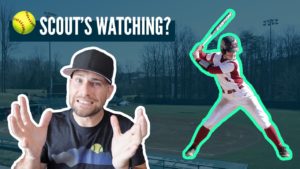*This article may contain product links which pay me a small commission if you make a purchase. Learn more.
In this episode, Nick Esposito of Fastpitchstrength.com joins to give three great strength training tips. We also discuss velocity gains from various throwing mechanics fixes and what players can expect. Follow Nick on Instagram or visit Fastpitchstrength.com.
To submit a question for the Good Questions Q&A segment, make a voice recording and email it to Dan at hello@danblewett.com.
Want to support the show? Enroll in one of Coach Dan’s online throwing courses or his mental skills course. Use code GOODADVICE to save 20% on any course, just for being a listener.
Sign up for Dan’s Email list and get his free throwing eBook, and follow up with him on the interwebs: YouTube Channel | Twitter | Snapsoftball.com
Podcast: Play in new window | Download
Subscribe: Apple Podcasts | Spotify
Full Transcript: EP Good Advice Softball Podcast EP6 – Softball Strength Tips with Nick Esposito of Fastpitchstrength.com
You are listening to the good advice, softball podcast. I’m Dan Blewett. And on this show, you’ll learn how to help the softball player in your life. Sharpen her skills, improve her mindset and find new confidence through softball.
Hey, welcome back. Softball, parents, players, coaches. I’m Dan Blewett. And this is the good advice softball podcast. Today. We’ve got a little bit of unique show. We’ve got, some guests, advice. So Nick Tuenello from fast pitch strength.com is going to be, giving you just a couple of quick tips. So number one, how old should you be when you start strength training?
Number two is going to share one of his favorite exercises, which is the plank and how to, do it properly. And number three is going to talk a little bit about. In season lifting. So, in today’s show, we’re going to go over or that stuff. But Nick Esposito is a friend of mine. He’s a really good strength coach.
He’s worked with baseball and softball players. She’s a currently up in Boston, Massachusetts, where he worked with people in person. And, so yeah, so the first thing we’re going to talk about, we’ve chatted about this on my YouTube channel before, but at what age should you start strength conditioning.
So let’s listen into a little bit about what Nick has to say about that. Hey everyone, Nick here from fast pit strength. One of the most common questions, ones that I get is when should you start strength training? What is a good age to start strength training. I hear it all the time from parents, players and coaches.
And while I really wish that there was like a magic age that says, yes, Let’s now go in the gym because we’re 15, for example, we know it’s not that easy. So there’s a lot of things I play. There’s a lot of variables at play. Everyone develops a little bit differently and we need to respect that. Right.
Everyone has their different point of maturity. So when we start looking at strength training, I like to view it as softball skill. Right. We have to work on it little by little. We have to work on those small skills. They’re going to make us better over time. Right? You have to put in the effort to get better at your swing by taking T work or working specific drills to get better throwing mechanics.
Right. There’s a lot of things that we do as softball players to work on those skills. The gym is no different, right? So when it comes to a starting point, you know, a good general age, I would say that I start with athletes is around 12, 13. We really start learning the fundamentals of movement patterns.
We’re learning to hinge, we’re learning to squat. We’re learning to do a proper pushups. We’re learning to row better, get good arm strength. There’s so much at play that, you know, as we. Spend time earlier on working on those skills, it’s going to set you up better for longterm development, because as you get older, you’re already going to know the form.
You’re already going to know the movement. Now, as you’re entering a maturity, we’re able to start bloating, that movement pattern. So, Oh, a body weight squat, or a counterbalance squat at 12 and 13 teen is all of a sudden becoming a goblet squat or. A front squat or a potential other like a safety bar squat, for example, there there’s so many options that open up, but if you’re 16, 17, you have to learn that movement pattern first and then, you know, start loading it.
So you might be behind some players that have started earlier. so that’s a good general rule that I like to use is just spend the time to build your foundations because as you get older, you’re going to really rely on that to really hit your true potential in the gym. All right. Some good advice. So obviously, you know, if you don’t start young, you’re not going to get that foundational stuff and really be able to build on it because the thing was strength training is, and again, I want everyone to start this one, they’re ready.
So you can’t force your daughter to do strength training when she’s young, she’s going to hate it. She’s going to rebel against it. It’s not going to turn out the way you want it to, so they need to be ready to do it. They, you know, they should want to do it themselves. and what that means is that typically it’s going to be these, you know, the more serious players, right.
But you have to, as a parent, I think find ways to get your kids excited about stranger things so that they do it themselves. And often that’s going with a group of their friends and their peers, and it is a more social thing to do, you know, when they’re younger, which is great. So, you know, the gym can be a scary.
A scary place for a young girl, especially where it’s just intimidating. There’s all this metal they’re afraid of not being strong enough. They’re afraid of looking silly. You. We know we’ve seen this. Over every year, in my, my Academy. So it’s a, it’s, it’s great to start young if they’re ready for it.
And again, by the time, you know, you get to 16, 17, you’ve got a training age of four or five years. I mean, you’ve got a lot of training under your belt and now you’re well underway to being a really formidable yeah. Fleet. So let’s talk about, one of Nick’s favorite exercises. Planks are one of the most popular core exercises.
They are a very good anti extension core exercise. It is also one of the most commonly core exercises out there. And what I mean by that is players. We tend to just want to hold a plank for as long as we can. Right. More is better. We kind of have that mindset of like, Oh, applying for 20 seconds is good.
I’m going to hold it for two minutes because it’s going to make me that much better. But during that time, what tends to happen is players. We tend to just dive into the front of your shoulders, which now we’re putting a lot of unneeded stress. Into the front of the shoulders. and then also too, we tend to sag your hips are a little, our backs tend to drop, right?
So now we’re just kind of hanging in shoulders and we’re also hanging in your lower back over time. It is not the most ideal position to be in, especially for softball players who we know already have a hard time with lower back. Injuries and lower back soreness as well as shoulder issues and hypermobility.
So that is something that we have to be very aware of as we are working on planks. So one of the things that I like to recommend is I like to get into a good plank position. I’m going to try to squeeze the floor as tight as I can. I’m going to try to crush my elbows to my toes. And I’m going to try to hold that position for about 15 to 20 seconds.
I guarantee you we’ll be having a. Way tougher challenge to that plank. And you won’t be needing to put as much stress or unneeded pressure into your lower backs and shoulders. So give that a try. Yeah. So that’s a good point. So with planks times, it’s overlooked exercises as far as technique goes.
So what Nick’s explaining as far as getting whole body tension, right? Really squeezing the ground, like squeezing your legs, squeezing your butt, squeezing your stomach. Those are really important because the plank is about stability, as you mentioned. And a lot of times we just get in that position and you hold it.
But a plank when done right, is something that’s, it’s tough to breathe during. It’s tough to talk during not, it’s not as social of an exercise as people think it is. Even a lot of times, you’ll see a team doing them around a circle and, you know, it’s. Kind of just like chit chat hour, but with plans, they’re all about building core stability.
And so when we do that, we’re trying to build this tension and that’s where it comes from really squeezing a lot of the muscles in your body. So really good tip there. If you’re doing planks with your team. Yeah. You don’t need to be doing from multiple, multiple minutes. No, those are easy. I’m not sure easy with those mental challenges once in a while are great, but I think his advice really rings true here.
So let’s grab his opinion on end season lifting. Cause this can be kind of complex. It is one of the most common myths. And honestly, one of the most common reasons why players do not lift in season is the, I don’t want to be sore mindset. And I’m going to tell you now, if you prepared properly during the off season, if you prepared your body the right way, you will not be sore.
Your program should not be making you sore for your games. If it is you’re going to have to reevaluate what that program. consists of in terms of volumes sets reps, there’s a lot of variables in play, right? Cause a good in season program is good. Maintain your, your movement quality. It’s going to maintain the health of your tissue, your ligaments and joints, as well as maintaining your strength, but also building strength.
Right? We still have the opportunity to continue to build, right. It’s just going to come down to what your structure is in terms of your schedule for softball. And how many days a week you have that you can actually commit to strength training, right? It doesn’t need to be a long program. It just needs to be something that’s going to maintain everything that you’ve built during the off season, but also continue to build and keep your on-field performance at a high level.
Yeah. So wholeheartedly agree with, with Nick here, when you’re lifting program has done, right. It shouldn’t make you sore during the season. What this typically means. Is not as many sets. So if you’re typically doing like threes at the 10 or 12 or four sets of 10 to 12 of an exercise, like say a goblet squat, or a pushup in season, you’re maybe doing three sets of six or four sets of five, or, you know, three sets of eight.
You’re just going to shorten the volume a little bit. And you’re also going to choose exercises a little more judiciously. And this is where having good strength coach comes in. Is some exercises are going to cause more soreness than others. So it’s about figuring that out and finding a balance. And so, you know, sometimes you can do this yourself.
Sometimes you really do need the advice of a good strength coach and whoever, as Nick said, whoever’s built your program for the off season should be able to help you tailor it down. And. And make it a suitable end season version. That’s going to help you stay on track and, you know, basically just not lose everything you gained in the off season.
So that’s a, that’s a really important, it’s really important to not give up, because when you think about how long your season is, you know, six months of the year, sometimes between spring and summer, You can’t just give away all of your gains for that six months and just not work out under the fear of being sore.
I mean, that’s half your year. And so when you start to compare yourself, if you take that six months off and you start to compare that to girls who don’t well, they got six more months of training from you, or then you. Times four years in high school that’s they got two, four years of training. You like, you don’t want to give that up.
I mean, you want to be one of those athletes that trains nine or 10 months a year. That’s why, again, I say, when you’re, you know, you need to be really, so he ready to start lifting because once you do it, you’re going to be on this train. That’s not going to stop until you’re done your playing career. And that train is going to be working hard nine or 10 months of the year.
So if you’re serious about your training and serious about playing at the next level, That means nine to 10 months of training, pretty much all year round. And some kids get closer to 12, but I think nine to 10 is pretty reasonable. We’re going to take a month off here and a month off there or whatever.
And, and recuperate recuperate a little bit, or you’ll just have to be too busy from other sports. So. Really good advice. So if you’re you’re new to Nick Esposito, definitely check out fast strength.com. He’s also on Instagram at Esposito strength club. so definitely check him out on the web. He’s got great advice.
He’s a great coach. And if you’re interested to work with working with him, you’ll be able to find out all that information on their website, which again is fast pitch, strength.com.
All right. Today’s 92nd mindset is for anyone. And I’m just going to pose a question. We’ll probably go over this in greater depth at some other point, but. Is the softball swing different than a baseball swing and should a softball swing be some sort of cut down version? the answer to both of those is no.
So if, if you’re a parent and you’re unsure that you’ve, this is a long lived myth. If you’re a parent, who’s heard this, that the softball swing is not the same as the baseball swing that you need to go to someone specifically to, to teach the softball swing, quote, unquote, that is just. It’s malarkey. I don’t use that word very often.
It’s kind of dorky, but it’s malarkey. It’s we know whatever you want to call it. It’s hogwash. It’s garbage, it’s bad men and women. There are some differences, right? We know that, as far as athletic movements, there’s almost no movement in any sport. That’s needs to be different for a female athlete versus a male athlete.
Like why should a swing be different? Sure. Salt. This is the trajectory of a softball coming in is slightly different than a baseball players, because a baseball player is throwing it downhill. But actually I know the numbers in front of me. Like a softball. It goes underhand, obviously. So it goes up initially, but then it actually then does start to drop with gravity as it gets closer to the ground.
So unless it’s a rise ball, other pitches are going to have that downward trajectory still, that is going to still match that slightly uppercut swing that a baseball player has. Baseball players. This has been, you know, again, there’s, there’s so much slow motion video where you really can’t hide teaching sort of things with baseball players, they swing at a slightly upward angle and they don’t get cheated.
And this is to match the plane of the ball. So if you’re not familiar with what the plain of the ball is, it’s, if the ball’s coming in downhill at a six degree angle, you want to swing uphill at a six degree angle so that your, your barrel of your bat is on the same plane. That’s traveling. as the ball, that’s how you’re going to make the most consistent contact.
And you have more margin for error to not be exactly on time with the pitch and still hit it hard. So all of the best swing coaches out there who are really balanced and fair and objective, and always learning and trying to be better, all of them will say that the baseball swing and the softball swing are the same and that girls shouldn’t be cheated.
They shouldn’t take some sort of cut down. You know, feminine version of the swing, no swing, like swing the bat hard, don’t get cheated, drive the ball, get on playing with it. Anything that the baseball guy is doing and are doing. And there’s a lot of new research on hitting and there’s a lot of swing trackers and all this stuff.
that stuff is all fair game for softball players. Obviously, if you’re a slapper, it’s different, but we’re talking about players who are just going to swing regular. There’s no reason that should be, you should be thinking of a different, if anyone’s telling you that you should really ask them for the reasons why, and see if they get defensive about it.
If they just started talking about their own playing career, if they talk about what they were taught back in the day, or if they really have an objective Lee, good reasons. Cause I’d love to hear someone say to really lay out the reasons why girls shouldn’t swing, just like the guys do, because chances are, they don’t have really a leg to stand on.
All right. It’s time for good questions. Our listener Q and a segment. Remember if you have a question you’d like answered on the show, please email a voice recording to hello@danblewett.com. This is easy to do on your phone, through the voice memos app on iPhones or any voice recorder app on Android links to email me are in the show notes.
all right. And today’s question came from YouTube. So, obviously if you’re on my YouTube channel, I’ve got a lot of videos there. and one of the recent ones is about shoulder tilt. And so a parent asked, Hey, if I fix the shoulder tilt, how much is this going to improve throwing velocity? So with all these different things, this is the way I want you to think about throwing velocity.
So it’s not always, like I, I told him my, my response was. It could be quite a lot, but there’s just no way to give you an answer because I have no idea like what your daughter or your team’s throwing velocities are, or like where their athletics doesn’t miss or what, what the problem is. So if you’re trying to figure out on average, how much velocity could you gain by fixing the, your shoulder tilt, which is something, again, I encourage you to jump over to my YouTube channel.
I have a video called shoulder tilt equals everything about how to throw a softball. So basically the angle made by your shoulders needs to match your arm slot. That’s where your arm slot is made. Anytime. There’s a difference where it’s not this long arm. There’s a long. Kind of smooth angle. you’re pushing the ball.
And so this mismatch between your shoulder angle and your arm angle is very common in softball players and it needs to be fit. So, but with any velocity killer, any mechanics thing, anything in your softball, throwing mechanics, it’s never going to be like, Hey, this is going to give you five miles per hour, but this is the way I want you to think about it.
Imagine you were comparing yourself to another version. So you as a softball player, comparing yourself to your twin on another planet. And that’s when had, you know, she was bigger and faster. She also did more arm care exercises. She also had cleaned up mechanics or she fixed mechanics item a or mechanical item B.
You have a problem with her fixed mechanical flaws, C and D. You know, how much philosophy would she have over you? And this was a mindset I took as a baseball player in college. I was looking for ways I threw about 80 to 83 while 78 to 83 as a freshman. And I knew I had to throw 90 plus to get drafted.
And, so. I was looking for 10 miles per hour, essentially, or a little more. And I said, where can I get 10 miles per hour? And I was like, well, okay. I’m 172 pounds a year as a freshmen. So if I gained a bunch of weight and I’m 190 pounds, how many miles per hour would that give me? I don’t know, maybe like three or four, like bigger, bigger, stronger dudes.
They tend to throw harder than skinnier, weaker dudes. Right? So I said, all right. So if I get really big and strong, maybe I’ll get like three or four miles per hour. Then if I improve my mechanics, they’ll maybe go get another like two or three or four miles per hour. Then if I do a lot of arm care where my rotator cuff is super strong, because my rotator cuff is one of the main lecturer of engines of pitching velocity.
That’ll be another like two miles per hour. Then if I increase my flexibility, cause I was kind of tight, like in my hips and my quads and all that stuff. So I did yoga a bunch and I learned a lot of wacky stretches and I said, well, my hips move better. Maybe they transfer more power. So maybe like another two miles per hour from there.
And so you start to add all that up. You’re like four, four, two, two, one. And sure enough, I ended up throwing, I was mostly a 92 to 94 mile per hour pitcher and pro baseball. So it’s kind of like that. If you started to just really be honest with yourself and take an audit of your ability and say, where can I find.
You know, two miles per hour, where can I find three more miles per hour? You’re never going to know what you’re going to get out of it. Like no coach, if some coaches are predicting it, you know, like I know if I’ve worked with a player that’s never had much instruction. She’ll probably gain five miles per hour in a month, or two of us working there.
Cause she’s had just like no instruction in general. Right? It’s like taking someone off the couch and put them in with a great personal trainer. They’re definitely gonna lose some weight right away, because they haven’t been doing anything. Right. So that stuff’s not hard, but it’s hard figuring out like, okay, when you to have some sort of base or you don’t have that many right issues to clean up, like how much philosophy can you get when you start to improve stuff?
Right. So the metrics are never clear. But you should take the mindset of look for holes. So are you doing arm care? Are you flexible? Are you big and strong for your size without being overly bulky? Right? are you, are your mechanics good? If your mechanics aren’t good. Have you had someone like me?
Analyze them and say, here’s where a bunch of flaws are that are holding you back when you do all that. So then you could say, okay, I have these six things I could probably find velocity in. And if I got like one or two miles per hour in each that’s like six to 12 miles per hour and that’s pretty good.
So, it was a good question on YouTube. And I want to expand on a little bit here and hopefully that helps, because again, you have to be honest with yourself. You have to kind of take an inventory of what’s going on. And after that, then you can figure out. How you can make the most progress.
Well, that’s all the good advice I’ve got for today. If you enjoy the show and would like to support me while also helping yourself enroll today. And one of my online softball courses, my she’s got a Canon throwing courses come with pricing plans for any budget. And my resolute athlete, mental skills course will help your daughter or team build the mindset of a champion.
Enroll in any of my courses through the links in the show notes and save 20% with code good advice just for being a listener. Be sure to subscribe to my weekly email list where you’ll get updates on all my new videos and episodes, nearly 4,000 people get my emails and you should to sign up for the link in the show notes.
Lastly, who do you know, who can use some good advice? Please share this podcast with a friend, subscribe on iTunes, Spotify, or wherever you listen to podcasts and subscribe to my snap softball, YouTube channel, where you’ll find this podcast and hundreds of softball, instructional videos. Back when I was a player, I was always thankful for good coaches and good advice.
I’m Dan Blewett and I’ll see you next time. .

